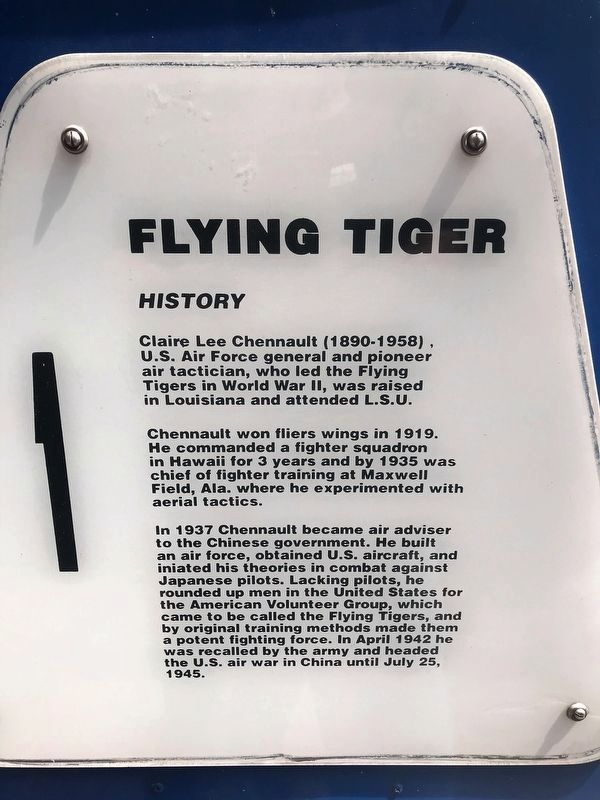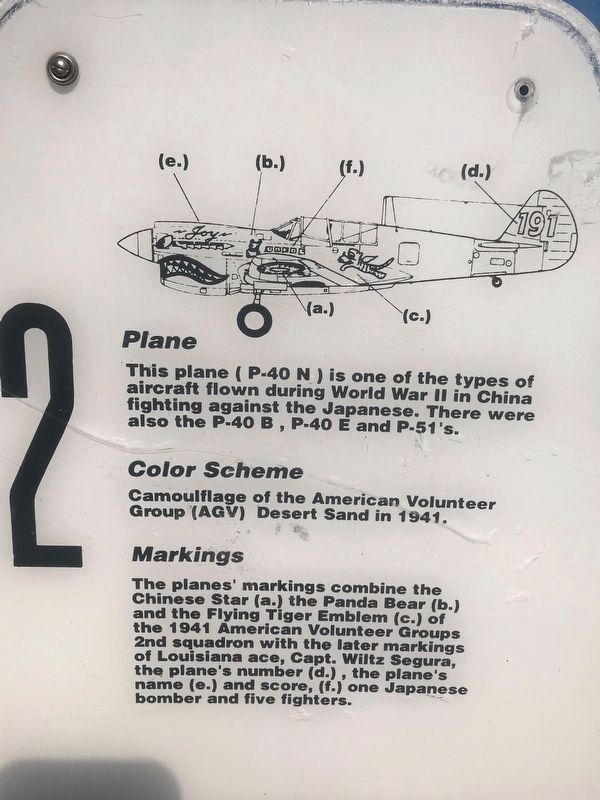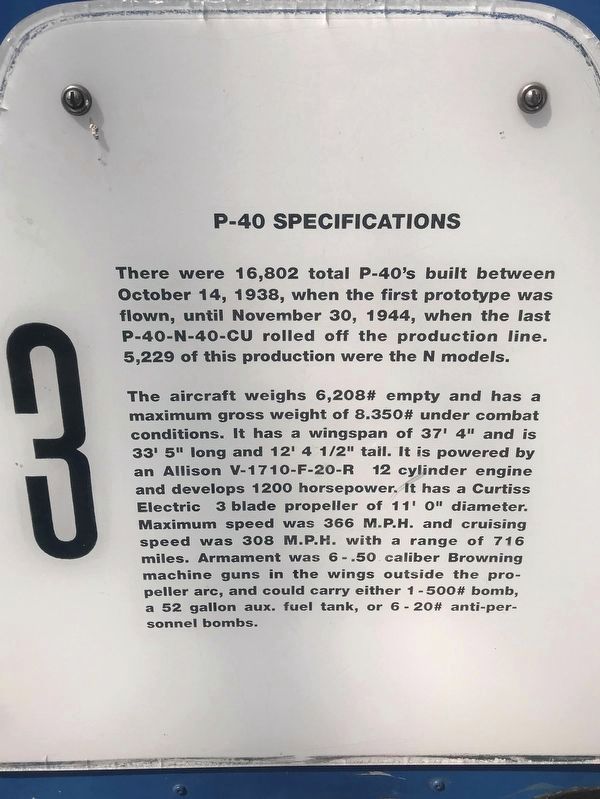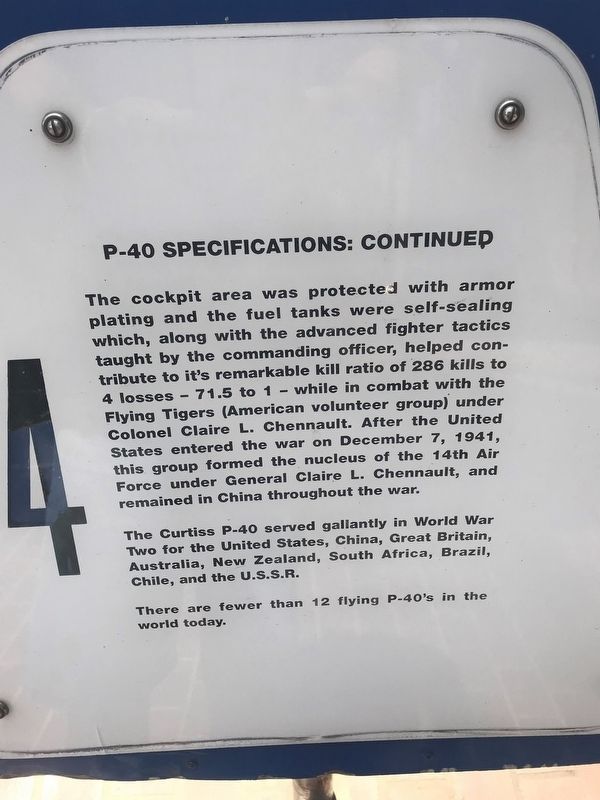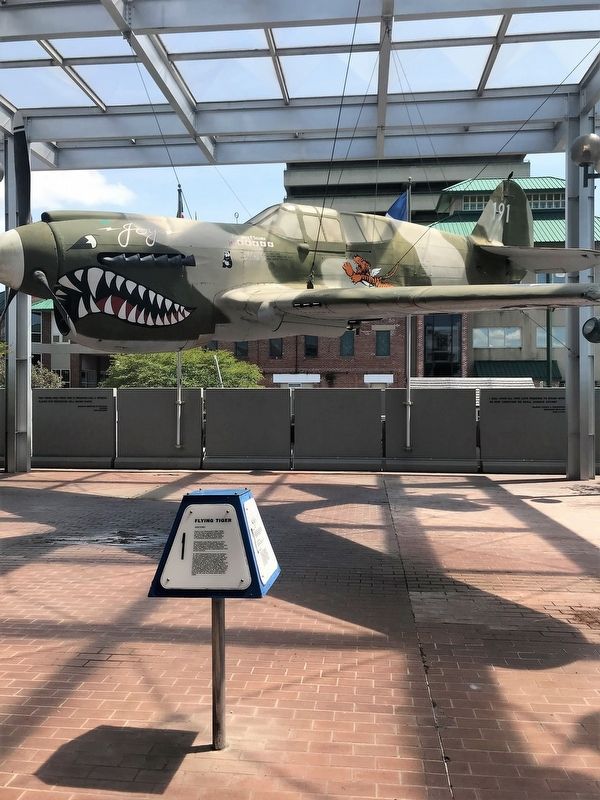Baton Rouge in East Baton Rouge Parish, Louisiana — The American South (West South Central)
Flying Tiger
Claire Lee Chennault (1890-1958) U.S. Air Force general and pioneer air tactician, who led the Flying Tigers in World War II, was raised in Louisiana and attended L.S.U.
Chennault won fliers wings in 1919. He commanded a fighter squadron in Hawaii for 3 years and by 1935 was chief of fighter training at Maxwell Field, Ala. where he experimented with aerial tactics.
In 1937 Chennault became air adviser to the Chinese government. He built an air force, obtained U.S. aircraft, and iniated his theories in combat against Japanese pilots. Lacking pilots, he rounded up men in the United States for the American Volunteer Group, which came to be called the Flying Tigers, and by original training methods made them a potent fighting force. In April 1942 he was recalled by the army and headed the U.S. air war in China until July 25, 1945.
This plane (P-40 N) is one of the types of aircraft flown during World War II in China fighting against the Japanese. There were also the P-40 B, P-40 E and P-51's.
Camoulflage of the American Volunteer Group (AGV) Desert Sand in 1941.
The planes' markings combine the Chinese Star (a.) the Panda Bear (b.) and the Flying Tiger Emblem (c.) of the 1941 American Volunteer Groups 2nd squadron with the later markings of Louisiana ace, Capt. Wiltz Segura, the plane''s number (d.), the plane''s name (e.) and score, (f.) one Japanese bomber and five fighters.
There were 16,802 total P-40's built between October 14, 1938, when the first prototype was flown, until November 30, 1944, when the last P-40-N-40-CU rolled off the production line. 5,229 of this production were the N models.
The aircraft weighs 6,208# empty and has a maximum gross weight of 8,350# under combat conditions. It has a wingspan of 37' 4" and is 33' 5" long and 12' 4 1/2" tall. It is powered by an Allison V-1710-F-20-R 12 cylinder engine and develops 1200 horsepower. It has a Curtiss Electric 3 blade propeller of 11' 0" diameter. Maximum speed was 366 M.P.H. and cruising speed was 308 M.P.H. with a range of 716 miles. Armament was 6 .50 caliber Browning machine guns in the wings outside the propeller arc, and could carry either 1 - 500# bomb, a 52 gallon aux. fuel tank, or 6 - 20# anti-personnel bombs.
The cockpit area was protected with armor plating and the fuel tanks were self-sealing which, along with the advanced fighter tactics taught by the commanding officer, helped contribute to it's remarkable kill ratio of 286 kills to 4 losses - 71.5 to 1 - while in combat with the Flying Tigers (American volunteer group) under Colonel Claire L. Chennault. After the United States entered the war on December 7, 1941, this group formed the nucleus of the 14th Air Force under General Claire L. Chennault, and remained in China throughout the war.
The Curtiss P-40 served gallantly in World War Two for the United States, China, Great Britain, Australia, New Zealand, South Africa, Brazil, Chile, and the U.S.S.R.
There are fewer than 12 flying P-40's in the world today.
Topics. This historical marker is listed in these topic lists: Air & Space • Military. A significant historical month for this entry is April 1942.
Location. 30° 26.58′ N, 91° 11.419′ W. Marker is in Baton Rouge, Louisiana, in East Baton Rouge Parish. Marker can be reached from South River Road near Government Street, on the left when traveling south. Western terminus of Government Street. Touch for map. Marker is at or near this postal address: 305 South River Road, Baton Rouge LA 70802, United States of America. Touch for directions.
Other nearby markers. At least 8 other markers are within walking distance of this marker. John Archer Lejeune (within shouting distance of this marker); Korean War Memorial (about 300 feet away, measured in a direct line); USCGC White Alder (about 300 feet away); Louisiana Vietnam War Memorial (about 300 feet away); A-7E Corsair II (about 400 feet away); USS Kidd Veterans Museum & Ship (about 400 feet away); Purple Heart Ship (about 400 feet away); USS KIDD - "DD 661" (about 400 feet away). Touch for a list and map of all markers in Baton Rouge.
More about this marker. Located on south patio of the USS Kidd Veterans Museum
Credits. This page was last revised on August 11, 2023. It was originally submitted on May 24, 2019, by Cajun Scrambler of Assumption, Louisiana. This page has been viewed 330 times since then and 20 times this year. Photos: 1, 2, 3, 4, 5. submitted on May 24, 2019.
